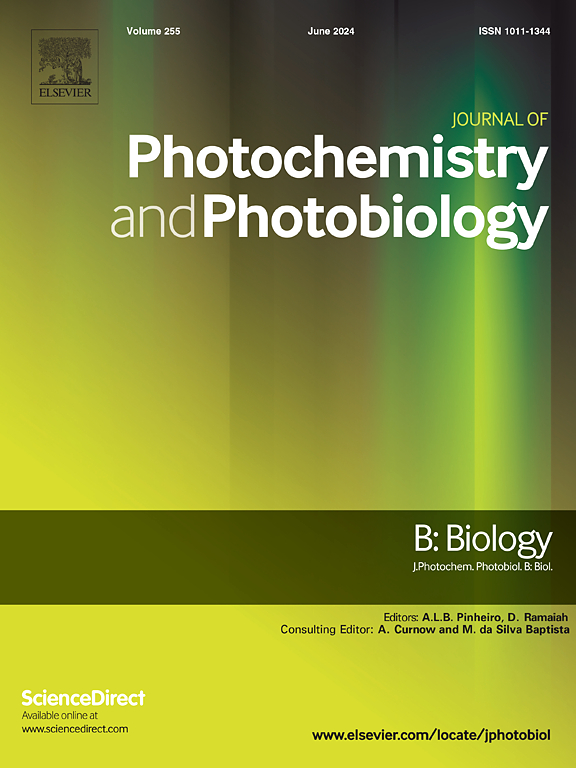短时间UV-B暴露减轻了苦荬菜的盐度胁迫并促进次级代谢物的产生。
IF 3.7
2区 生物学
Q2 BIOCHEMISTRY & MOLECULAR BIOLOGY
Journal of photochemistry and photobiology. B, Biology
Pub Date : 2025-10-06
DOI:10.1016/j.jphotobiol.2025.113279
引用次数: 0
摘要
Withania somnifera是一种传统上在印度干旱和半干旱地区种植的具有广泛价值的药用植物,在这些地区,盐胁迫和UV-B辐射的增加对其生产力和不同代谢物的药理质量构成越来越大的威胁。虽然盐度和UV-B胁迫的个体影响已经得到了广泛的研究,但它们的相互作用和对W. somnifera的交叉耐受潜力仍未得到探索。在盐(50 ~ 200 mM NaCl)、UV-B (1 ~ 4 h)和复合暴露条件下,研究了夏菖蒲(W. somnifera)的形态生理、生化和代谢反应。盐胁迫显著降低了植物株高、地上部生物量、光合效率(Fv/fm)和色素含量,同时诱导了氧化损伤。UV-B暴露增加了相对含水量,刺激了抗氧化酶(SOD、CAT、APX和GR)活性,促进了次生代谢物的积累。在盐和UV-B联合暴露下,植物表现出进一步的反应,其中抗氧化酶活性保持升高,而脂质过氧化水平下降,与单独盐胁迫相比,表明氧化损伤减少。由于短期的UV-B暴露,通过高分辨率质谱分析的代谢物分析显示,在甜菜碱和arjungenin等独特的应激反应化合物的诱导下,关键次级代谢物的积累协同增强,特别是野醇内酯、类黄酮和三萜。这些发现表明,短时间的UV-B暴露与盐胁迫协同作用,增强氧化还原活性和代谢重编程,以增强植物的适应能力。本研究为在盐碱化易发地区整合基于uv -b的农艺策略以提高苦荞麦的抗逆性和商业植物化学产量提供了基础。本文章由计算机程序翻译,如有差异,请以英文原文为准。
Short-duration UV-B exposure mitigates salinity stress in Withania somnifera (L.) Dunal and boosts secondary metabolite production
Withania somnifera is a widely valued medicinal plant traditionally cultivated in arid and semi-arid regions of India, where salt stress and rising UV-B radiation pose growing threats to its productivity and pharmacological quality of different metabolites. While the individual impacts of salinity and UV-B stress have been extensively studied, their interactive effects and potential for cross-tolerance in W. somnifera remain unexplored. In this study, we investigated the morphophysiological, biochemical, and metabolic responses of W. somnifera under salt (50–200 mM NaCl), UV-B (1–4 h), and combined exposure. Salt stress significantly reduced plant height, shoot biomass, photosynthetic efficiency (Fv/fm), and pigment content, while inducing oxidative damage. UV-B exposure alone enhanced relative water content, stimulated antioxidant enzyme activities (SOD, CAT, APX, and GR), and promoted the accumulation of secondary metabolites. Under combined salt and UV-B exposure, plants exhibited further amplified responses wherein antioxidant enzyme activities remained elevated while lipid peroxidation levels decreased compared to salt stress alone, suggesting reduced oxidative damage. Due to short-term UV-B exposure, metabolite profiling via high-resolution mass spectrometry revealed a synergistic enhancement in the accumulation of key secondary metabolites, particularly withanolides, flavonoids and triterpenoids, alongside the unique induction of stress-responsive compounds such as betaine and arjungenin. These findings suggest that short-duration UV-B exposure synergistically interacts with salt stress, intensifying redox activity and metabolic reprogramming to reinforce the plant's adaptive capacity. This work provides a foundation for integrating UV-B-based agronomic strategies in saline-prone regions to boost both stress resilience and the commercial phytochemical yield of W. somnifera.
求助全文
通过发布文献求助,成功后即可免费获取论文全文。
去求助
来源期刊
CiteScore
12.10
自引率
1.90%
发文量
161
审稿时长
37 days
期刊介绍:
The Journal of Photochemistry and Photobiology B: Biology provides a forum for the publication of papers relating to the various aspects of photobiology, as well as a means for communication in this multidisciplinary field.
The scope includes:
- Bioluminescence
- Chronobiology
- DNA repair
- Environmental photobiology
- Nanotechnology in photobiology
- Photocarcinogenesis
- Photochemistry of biomolecules
- Photodynamic therapy
- Photomedicine
- Photomorphogenesis
- Photomovement
- Photoreception
- Photosensitization
- Photosynthesis
- Phototechnology
- Spectroscopy of biological systems
- UV and visible radiation effects and vision.

 求助内容:
求助内容: 应助结果提醒方式:
应助结果提醒方式:


